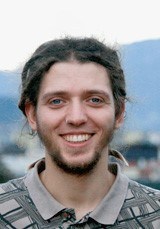In his interview with Thomas Coleman for the Religious Studies Project, Dr.Kevin Ladd talks about his research on prayer. Dr. Ladd explains how he got interested in the topic, clarifies some of the basic assumptions that need to be made up front, and then continues to answer questions about how this research is done and what it can tell us about prayer.
We must admit that when we first heard about empirical prayer studies, we were skeptical to what degree they could be free from obvious biases, which could lead to an apologetic motivation for the experiments and hence would hinder objectivity. Fortunately, Dr. Ladd explicitly addresses this problem in the interview when asked what questions can be answered with science concerning prayer. He explains how he sees prayer as a psychological phenomenon motivated by theological conceptions and reasoning which should be explained in psychological terms such as behavior and affect, and that research on this issue has to remain free of metaphysics. Ladd is clear that psychological research on prayer must exclude one’s own preoccupations with that issue. The focus is to understand how and why people pray. This is an important point, because otherwise research will be biased, preferring either an atheist’s or a believer’s point of view, each trying to justify their own assumptions.
Apart from our early apprehension, there were two things that especially caught our interest. The first is that Dr. Ladd does not give a universal definition of what prayer is, and the second is the idea of an atheistic or secular form of praying.
To define prayer is a very challenging task. In his bookThe Psychology of Prayer: A Scientific Approach, which Dr. Ladd wrote in collaboration with Dr. B. Spilka, prayer is largely defined as “an appeal to a higher power, invariably a deity conceptualized in a relational sense” (p. 12). Prayer can be performed in numerous ways out of a variety of different motivations and is influenced largely by religious doctrines and institutions. Sadly this definition does not overcome the bias that prayer must necessarily be addressed to a deity and is, as such, too narrow to include all forms of prayers, especially prayer among atheists.
”’Atheism’ designates a position… that includes or asserts no god(s)” (Eller, 2000,p. 1). So, for example, animism, as a religious worldview without any god, could involve praying, where the higher power appealed to is some sort of natural spirit, which is not a deity. This form of praying would not fit in the definition given above, although it should probably be considered. Apparently, this is not the problem that comes to mind most readily to people when they try to figure out what it means when an atheist prays. How can someone who rejects the “God Hypothesis” pray to a God?
At the beginning of theinterview, Dr. Ladd refers to a breast cancer survivors group called Reach to Recovery. This group got him interested in studying prayer after he had found out that many people who said praying was essential to their recovery also claimed they were atheists. We assume these people were not just praying to natural spirits but were explicitly praying to a god in a theistic sense. This leaves us with an obvious contradiction, which we think points towards a form of prayer that does not require the concept of a higher power in a relational sense. Maybe an atheist can conceptualize a deity and pray to it without assuming a relationship between them, because he (or she) is not convinced that the addressed conception is real. In fact, we think this may be the only way an atheist can pray to a theistic deity. Another example for this would be people who pray together with their family on Thanksgiving or who attend church out of tradition and pray there, although their worldview does not include a god or prayer typically.
Since there has not been a consensus on a universal definition for prayer yet and Dr.Ladd encourages different approaches towards the subject, we suggest defining prayer as an appeal to the concept of a higher power that can, but does not have to, be seen in a relational sense between the power and the person who prays. An atheist could perform all kinds of prayer in the exact same way a believer does but would not necessarily perceive his (or her) actions to be connected to a higher power. We think this might be the key difference between these two forms of praying.
The notion of atheists praying may be puzzling. If being an atheist means that someone does not believe in God, higher beings, etc., then what would be the purpose of a prayer? How can a prayer be performed? Who is the prayer´s addressee? One possible explanation can be found in the conceptof horizontal self-transcendence (SoMe questionnaire; Schnell, 2009), which suggests a non-theistic frame of reference becoming relevant for the development of one’s own meaning in life. Horizontal self-transcendence means committing oneself to a greater goal that is not determined by God or higher beings. For example, gaining self-knowledge or greater health are examples of such goals, but it could also involve feeling close to nature. In this sense, it is imaginable that practices like yoga, meditation, or mindfulness-based relaxation techniques are structurally similar to the practice of praying. Structural similarity can be seen in bodily postures or dedication to certain contents of consciousness. While praying (at least in a Christian context), one usually is in a calm, inside-bound pose, typically with eyes closed and hands folded. Concerning contents, persons praying as well as persons meditating often forget about the current processes that happen in the outside world and concentrate on what is happening inside. We see that calmness, inward orientation, and dedication to something bigger than oneself are also elements of practices like meditation or yoga. Can such practices really be seen as prayers? In common understanding, prayer means getting in contact with a higher entity and therefore implies an aspect of verticality. Therefore, it is questionable to what extent practices that are not bound to an entity bigger than oneself can be interpreted as ‘prayer’.
Nevertheless, what is it that makes praying a personal resource? Ladd & McIntosh (2008) show that praying is about perceiving oneself in a larger social context. Support is received and provided via a perceived connection to other praying persons as well as to a higher power. This thought can be a starting point for a better understanding of the positive effects praying has, e.g. on health.
Speaking of the nexus between prayer and healing, does it make a difference for someone who prays if the prayer’s aim (e.g. the recovery of a family member’s health) is notfulfilled? People pray even though they cannot prevent the death of a beloved person, but to them this may not mean that the prayer was ineffective. What then is it that makes people continue to pray even if the prayer does not seem to have the desired effect? Is it a mere cognitive bias that sticks believers to praying? Do believers think God is reluctant to answer their hopes and wishes? Are injustice, illness, and death seen as an ordeal in order not to unsettle one’s own beliefs? These questions go too far to be answered in a short interview but can contribute to a better comprehension of the practice of praying.
Furthermore, there could be a European perspective added to Ladd’s research. In “Meaning, God and Prayer” (2008), Ladd and McIntosh write about the use of prayer in non-religious contexts, which we tend to imagine as less conceivable in societies like Austria or Germany, in which a large group of people do not believe: Only 43% of Germans describe themselves as religious – among them especially elderly people (Köcher 2010). What is the role of praying in such societies? Are there differences to societies in which most of the people are believers? What does that mean for the practice of praying – will it be extinguished, or will some of its elements survive in other practices such as meditation?
References
Eller, J. D. (2009). What is Atheism? In P. Zuckerman (Ed.), Atheism and Secularity (pp. 1-18). Santa Barbara, CA: ABC-CLIO.
Ladd, K.L. & McIntosh, D.L. (2008). Meaning, God, and prayer: Physical and metaphysical aspects of social support. Mental Health, Religion & Culture, 11(1), 23-38.
Köcher, R. (2010, June 23). Schwere Zeiten für die Kirchen. Last access 2014, Feb 03 from faz.net: http://www.faz.net/aktuell/politik/inland/allensbach-analyse-schwere-zeiten-fuer-die-kirchen-1996617.html
Schnell,T. (2009). The Sources of Meaning and Meaning in Life Questionnaire (SoMe): Relations to demographics and well-being. Journal of Positive Psychology, 4(6), 483-499.
Spilka, B. & Ladd, K. L. The Psychology of Prayer: A Scientific Approach. New York: Guilford Press.





